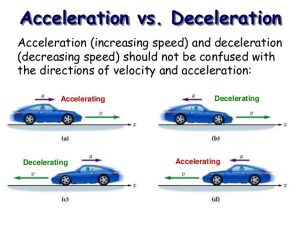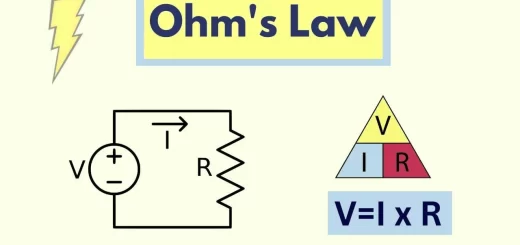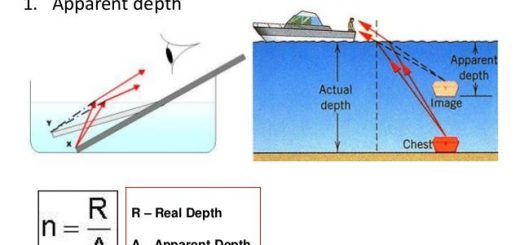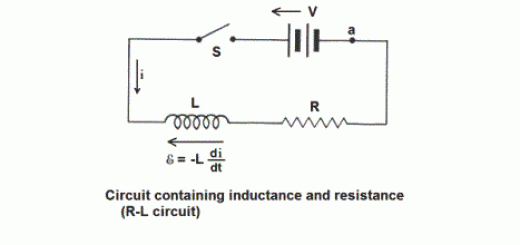Acceleration types, units, importance and Graphic representation of moving in a straight line
When the driver of a moving car uses the brakes, we describe the car movement as a decelerating motion because the car speed decreases as time passes. The ratio d/t remains constant in the case of a body that moves at a uniform speed because this body covers equal distances at equal periods of time. The body which moves at acceleration can’t move at a regular speed because its speed changes by passing time.
Graphic representation of moving in a straight line
Graphs and tables are important to physicists, Physical phenomena can be described and understood in many ways, Physicists use mathematical relations between variables to describe certain phenomena. Physicists use other mathematical relations like graphs and tables in order to:
- predict the relation between certain physical quantities.
- understand practical results.
- describe the physical phenomena in an easier way.
Graphic representation of regular (uniform) speed
Facts about regular speed in a straight line:
- The (distance – time) graph of a regular motion at a constant (uniform) speed is represented by a straight line passing through the origin point because the distance is directly proportional to the time, when the object moves at a constant speed.
- The (speed-time) graph of a regular motion at a constant (uniform) speed is represented by a straight line parallel to the time axis.
The (distance- times) graph of an object at rest is represented by a straight line parallel to the time axis. The relation (distance- time) graph for an object that moves at a non-uniform speed is represented as a curved line passing by the origin point.
Acceleration
When you sit in a car next to the driver and the car starts moving from rest in a straight line, you notice that the car speed increases gradually as time passes. When the speed of the car at 1 second becomes 5 m/sec., at 2 seconds becomes 10 m/sec., at 3 seconds becomes 15 m/sec. and so on.
To describe the change in the car speed in one second in this case, we use a physical quantity called “acceleration“. Acceleration is the change of an object speed in one second in a specific direction, or it is the rate of change of speed.
Acceleration (a) = Change in speed (ΔV)/Time in which the change occurs (Δt)
Acceleration (a) = [Final speed (V2) − Initial speed (V1)]/ Time (Δt)
Delta (Δ) means the rate of change of any physical quantity.
To calculate V1 or V₂: V1 = V2 − (a × t) , V2 = V1 + (a × t)
Measuring units of acceleration
Acceleration unit = metre/second². We use the acceleration unit (m/sec².) when the speed is measured in metre/second and the time is measured in second, or (km/h²) when the speed is measured in kilometre/hour and the time is measured in hour.
Guidelines to solve problems on acceleration:
- To calculate: Acceleration, Change in speed, and Time, a = ΔV/ Δt
- If the body is moving at a regular speed, so its acceleration equals zero because its speed doesn’t change as time passes [when (AV) = Zero, then (a) = Zero].
- If the body starts moving from rest, so its initial speed (V₁) equals zero.
- When the body stops moving, so its final speed (V₂) equals zero.
- When the car is moving, then the brake is applied to stop the car after a period of time, so, its final speed equals zero.
Uniform acceleration
When a car covers equal distances at equal periods of time, it is said that the car moves at a uniform (regular) speed. But if its speed changes (decreases or increases) by equal values at equal periods of time, it is said that the car moves at a uniform (regular) acceleration.
When the speed of the car increases by 10 m/sec each 2 sec, so, Acceleration (a) = (20- 10)/ 10 = 5 m/sec². Uniform acceleration is an acceleration by which an object moves in a straight line when its speed changes by equal values through equal periods of time.
When a car moves at a uniform acceleration equals 5 m/sec². This means that the car moves in a straight line and its speed changes with 5 m/sec. each one second.
Types of uniform acceleration
- Positive acceleration.
- Negative acceleration.
Positive acceleration
The object moves at a uniform positive acceleration (accelerating motion), when [Its initial speed < Its final speed]. Positive acceleration is an acceleration by which an object moves in a straight line when its speed increases by equal values through equal periods of time.
When an object moves at a positive acceleration equals 2 m/sec². This means that the object moves in a straight line and its speed increases by 2 m/sec, each one second. The sign (+) refers that the speed of the object increases regularly by 2 m/sec. each one second.
Negative acceleration
The object moves at a uniform negative acceleration (decelerating motion). [Its initial speed > Its final speed]. Negative acceleration is an acceleration by which an object moves in a straight line when its speed decreases by equal values through equal periods of time
When an object moves at a negative acceleration equals -2 m/sec². This means that the object moves in a straight line and its speed decreases by 2 m/sec each one second. The sign (−) refers that the speed of the object decreases regularly by 2 m/sec. each one second.
So, we can deduce the type of acceleration from the shape of the graph:
- Positive acceleration: when the object moves at (a non-uniform speed), V (initial) < V (final), So, it moves at an accelerating motion.
- Negative acceleration: The object moves at (a non-uniform speed), V (initial) > V (final), So, it moves at a decelerating motion.
- Zero acceleration: The object moves at (a uniform speed), V (initial) = V (final).
The acceleration is positive when its value increases, while it is negative when its value decreases because when moving with a positive acceleration, the final speed is greater than the initial speed, while when moving with negative acceleration, the final speed is less than the initial speed.
The object which moves at a uniform speed, its acceleration equals zero. A body moves at zero acceleration because its speed doesn’t change by passing time (ΔV = Zero).
Problems
• An object moves from rest and its speed reaches 20 m/sec. in 5 seconds. Calculate the acceleration of the moving object? What is the type of acceleration?
Solution
V₁ = 0 , V₂ = 20 m/sec. , Δt = 5 sec.
a = V₂ – V₁ /Δt
a = (20- 0)/5= 4 m/sec² , Positive acceleration.
• A train moves at a uniform speed of 20 m/sec. When the driver uses the brakes, the train stops after 4 sec. Calculate the acceleration at which the train moves and mention the type of acceleration.
Solution
V₁ = 20 m/sec. V₂ = 0 , Δt = 4 sec
a = V₂ – V₁ /Δt
a= (0 – 20)/4 = – 5 m/sec² , It’s decelerating motion
• A car driver moves at a speed of 80 m/sec. used the brakes to make the car moves at a uniform decreasing acceleration 2 m/sec? Find the car speed after 12 seconds from using the brakes.
Solution
V₁ = 80 m/sec , V₂=56 m/sec , a = – 2 m/sec , Δt = 12 sec
V2 = V1 + (a × t)
V₂ = 80 + ( – 2 × 12) = 56 m/sec
Guidelines to solve problems
On moving at a uniform speed through the period of time (AB) and then followed by the movement at a uniform acceleration through another period of time (BC). So, The uniform speed through the period of time (AB) = The initial speed through the period of time (BC). [V₁ at point (B)].
• An object moves in a straight line at a regular speed. If the time taken by the object to move from (A) to (B) is 4 seconds, then it moves at a uniform acceleration from point (B) until it stops at point (C) in 20 seconds. Calculate each of the following:
- The regular speed of the object to cover the distance (AB).
- The uniform acceleration by which the object moves from point (B) to point (C).
Solution
1. Regular speed at (AB) = Distance/Time = 40/4= 10 m/sec.
2. The initial speed at (BC) = The uniform speed at (AB) = 10 m/sec
The uniform acceleration at (BC) (a) = (V₂ – V₁)/At = (0 – 10) /20 = – 0.5 m/sec²
• A car moves at a speed of 60 m/sec., if the driver used the brakes to decrease the speed by 3 m/sec. Calculate the time after which the car stops?
Solution
V₁ = 60 m/sec, V₂ = 0 , a = – 3 m/sec² , Δt = ?
a = (V₂ – V₁)/ Δt
Δt = V₂ – V₁/ a
a = (0 – 60)/- 3
a = 20 sec
You can subscribe to Science Online on YouTube from this link: Science Online
You can download the Science Online application on Google Play from this link: Science Online Apps on Google Play
Physical Quantities, Scalars, Vectors, Distance, Displacement, Speed & Velocity
Motion in one direction, Types of Speed, Average Speed & Relative Speed
Types of motion, Relative motion, Applications of Mechanical waves & Electromagnetic waves
Role of waves in transferring energy, Wave Motion, Transverse waves & Longitudinal waves
Laws of circular motion (Centripetal Acceleration, Tangential linear Velocity & Centripetal Force)














